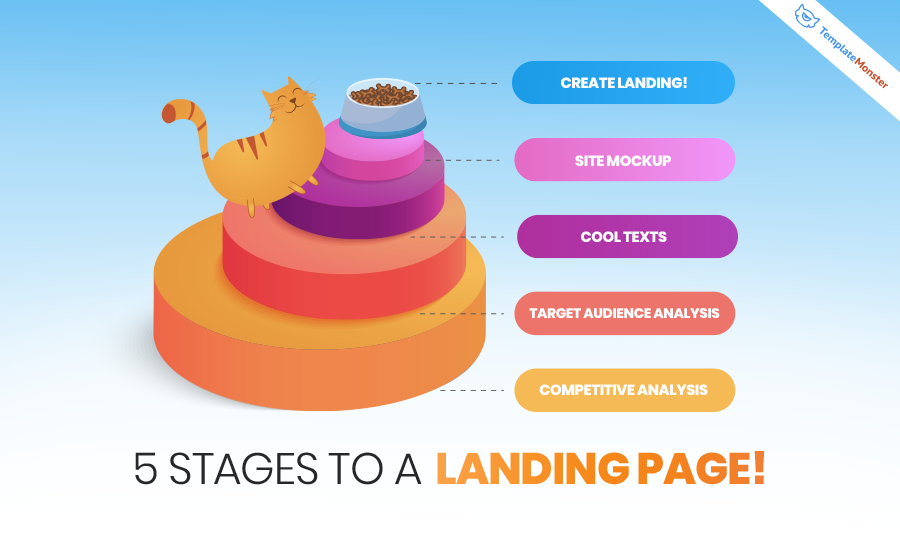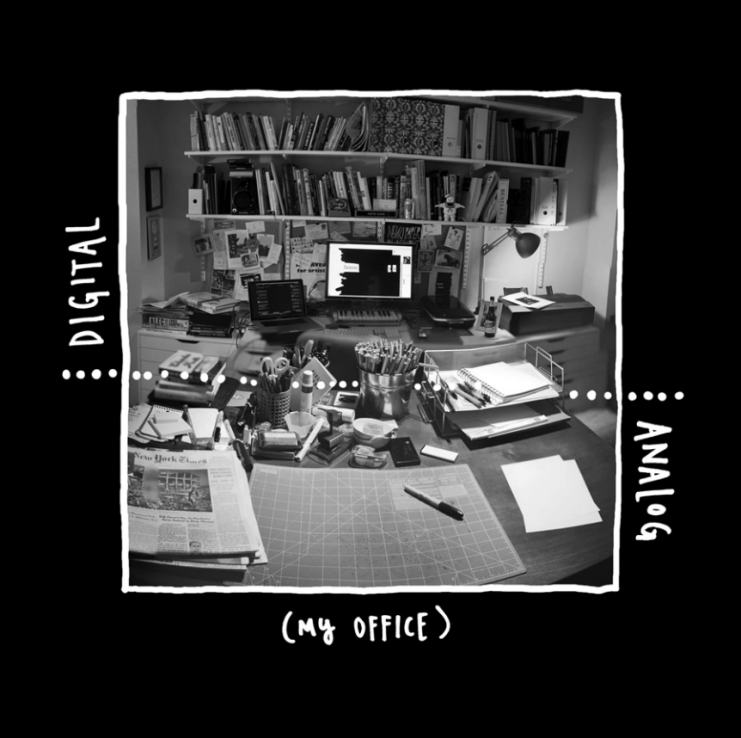Lesson 2. How to Create Landing Page Websites: 5 Stages
*This article is a part of the Landing Page Building Course by TemplateMonster
Referring to the first part of this course, you know for sure what landing page (one-page) sites are, what purposes they cover, and what perks they can bring.
In this article, we are going to stop at each stage of building a real landing page website. If you’ve never done it before, it’s highly recommended not to miss any of the steps. Be very careful and you’ll likely create an eligible website!
Here are the stages of building landing page sites:
| 1 | Make a competitive analysis |
| 2 | Make a target audience analysis |
| 3 | Prepare texts |
| 4 | Develop a mockup of your landing |
| 5 | Create your landing! |
Let’s start!
- Stage #1 - Make a Competitive Analysis
- Stage #2 - Make a Target Audience Analysis
- Stage #3 - Prepare Texts
- Stage #4 - Develop a Mockup of Your Landing
- Stage #5 - Create Your Landing!
Stage #1 - Make a Competitive Analysis
As people want to be different from others, they tend to buy unique products. So, offer them what definitely stands out in the crowd. That’s called a unique selling proposition. The idea is to concentrate on your customers’ values.
A unique selling proposition (USP or also a unique selling point) - is a factor you should accept holding a competitive analysis. It’s what actually makes your product different from those your competitors offer. Usually, it’s powered with the lowest cost, the fastest delivery, lots of bonuses, and so on.
“Move fast. Speed is one of your main advantages over large competitors.”
Sam Altman
Define Your Competitors
To find out who your competitors are, you need to know where you can meet them. As a rule, they are at the same place where you’re going to put ads - in one or several customer acquisition channels. If Facebook is your advertising space, then it’s reasonable to search for competitors there. That will help you to differentiate yourself and will make your USP stronger. Also, pay attention to the behavior of your target audience in a certain place at a certain time.
NB! Looking for competitors, comply with the next terms:
- Time (business hours or only at night, on weekdays or weekends only, etc.)
- Place (any geographical data, like if it’s a large city, tiny town, region, etc.)
- Traffic Channel (Facebook, Google Chrome, Instagram, etc.)
As an example, for contextual advertising, make a search up to the same queries and at the same time, your potential clients may be Googling your product. It may also happen that your customers look for products only during business hours. That’s why your competitors advertise during business hours. In such a way, there’s no reason to “spy” on them at night or on the weekend. What to do then? Check every possible selling-buying time if you want to achieve some overall results.
As well, you can study newspaper ads to define your competitors.
If you plan to put ads on socials, create such an account that your target audience representatives may run. It will give you an opportunity to see on your own what competitors offer and how they act.
Now, look at this table. It’s really helpful for competitors’ comparison and includes the optimal criteria:
| Competitors | Customer Acquisition Channels | Customers Needs | Additional Benefits for Clients | USP | What Can Be Enhanced?
Weaknesses |
| Competitor #1 | |||||
| Competitor #2 | |||||
| Competitor #3 | |||||
| Competitor #4 | |||||
| Competitor #5 |
Summing the aforementioned up:
#1. Put yourself in your clients’ place. Try to act as they do up to a specific time, place, and traffic channel.
#2. Discover what at least 20 of your competitors offer.
#3. Make phone calls to your competitors to find out how they work with clients.
#4. Create a comparison table of competitors.
What’s Next?
At the stage when you’ve found and analyzed the products of your competitors, concentrate on their weaknesses. Write down the competitors’ cons and replace them with the benefits you offer. Pay even closer attention to the perks your competitors promise their clients. Having analyzed that, make something better, more comfortable to order, with faster delivery, and bonuses. If your opponents have only one customer benefit, offer two!
Generally, an ideal unique selling proposition (USP) appears in two wide-spread cases:
#1. When clients can’t but BUY. In this case, people are afraid to look like fools, as the proposition is so attractive, so advantageous, and urgent. It can be purchased only at this time, on this specific website.
#2. When clients think they do NOT need a product from the first sight of it. Still, while looking at it, they realize all uniqueness, quality, and benefits of the proposition. Eventually, they change their mind.
It’s necessary to make such a combination of 2, 3 or 4 USPs that nobody has. Or, if it’s impossible to invent something new, get assured that your USPs are truly better, more powerful, and useful.
Hopefully, that’s also clear enough that you can’t cheat on USPs. Promise only those clients benefits you can fulfill! And don’t forget to check if a very robust USP can cause harm to your business.
Summing this paragraph up:
#1. Find the weaknesses of your competitors.
#2. Adjust your clients’ benefits.
#3. Create new powerful USPs, make them better than what your competitors have.
The first step to building a landing page website has come to its end. This part is small but there’s a lot of work behind it. Since we have a practical course on creating landing pages, we try to share information in approximately equal pieces, like in school.
Professional Views

Defining competitors can be a slippery slope. The goal of your brand is to stand out in the marketplace. And if you truly stand out, you will have no competitors. Because by definition, there is no other brand that does what you do.
That being said, when you first start out, it might be hard to differentiate yourself. Look at other brands that offer the same services as you in the same locations. The brands that connect with the customers you’re looking to connect with through a similar conversation. These can be considered your competitors.
But again, your goal is to stand out. So don’t imitate what your competition does. Instead, see what they do and then think about how you can pivot into your own lane.
Name any particular business, and it shall be related to one or two niches.
These niches, or industries, also house various others who offer the same
or similar services as you. For a businessman, others who aim to build a
customer base based on the services they provide can be considered as
competitors.

Stage #2 - Make a Target Audience Analysis
Define Your Target Audience
A target audience is a composite of various groups of your potential buyers. It’s also often called a “customer avatar.” We are not an exception and going to use this term, as well.
“Choose clients as you would friends.”
Charlie Munger
Target Audience Understanding = Perfect Proposition = Big Sales
There are lots of entrepreneurs that just don’t hear their customers. Imposing products that don’t match their requests lead to lack of sales. Just think logically! People have lots of worries. Therefore, they want to spend their money on what gives them emotions and fixes their problems. To satisfy the requirements of your target audience, give them what they want.
And, all customers want (up to Forbes.com):
- Personal approach
- Consistent feedbacks
- High quality of products and fairness
- Zero repeats (it mostly depends on a product or service and means efficiency)
So, always be within sight of your target audience, just a little ahead of your competitors and use some “magic kick” to make people BUY your product.
Selling everything for everyone also sounds like nonsense. Segment into narrow groups of clients and show them what they can benefit from by dealing with you. Tell your audience what a well-experienced specialist you are. Introduce yourself as a serious business based on knowledge and practice. In a while, you’ll watch your sales grow. To do it easily and correctly, be sure that you know your clients.
“The best way to look at any business is from the standpoint of the clients.”
Charlie Munger
You can rely on these aspects while making your target audience analysis:
- Gender
- Age
- Marital status
- Education level
- Income level
- Hobbies
- Cultural and social background
Professional Views

Google Analytics is a great tool for tracking users and finding demographic
information. Utilize that data to craft personas that will guide your
marketing efforts.
Most of my target audience comes from social media for small business
owners (Alignable) and answering questions (Quora) for people. Also, those
searching for topics on web design are what they're doing so Google is a
helpful resource for finding my target audience.

Create Customers Avatars
To get closer to your clients and understand them better, put yourself in their place and ask “Who am I?” It will help you to develop your advertising strategy that can be hard when a product suits both mothers and daughters. Many young girls won’t buy something their moms will. So, in this case, two completely different promotion approaches to customer acquisition channels will save the situation. You may wonder what product, as it seems impossible. What about a shower gel? It’s not about problem teen skin or anti-age effect, just aroma and hygiene - for both mothers and daughters. Likewise, ask yourself, “Why do I choose this product? What is special about it?”
To get the most exact answers to these questions, you can with the help of customers avatars. This method is appreciated by the best marketing specialists when there’s no real possibility to ask your potential clients directly.
A customer avatar is a distilled embodiment or profile of your ideal customer. It’s a combination of all the characteristics and personality traits gathered in a single individual.
Every business, as well as yours, has several customer avatars. They may be similar or radically unlike. It’s crucial to understand every one of your avatars. Be attentive to their problems, needs, fears, and motivation.
The main task is to find out who needs your product the most and who will buy it with the greatest will. Ask yourself, “Whose and what problems will you solve?” Build and discover as many avatars as is achievable.
For example:
You start selling cars. Accordingly, your customer avatars can be:
#1. A family - children need to be driven to kindergarten/school, their parents are hurrying for work, and on the weekends the whole family can visit grandparents, the zoo, cinemas, etc.
#2. Top manager - a potential owner of premium car
#3. A taxi driver - a car as a tool for delivering customers from point A to point B
Another example:
You make doors. Then look at avatars you may have:
#1. Families - some of them are planning to make repairs or are already involved in it
#2. Interior designers - they must need your doors for their projects
#3. Companies that participate in tenders for interior decoration
There are just examples. In practice, there can be dozens of avatars for varied business niches. So, create at least five customer avatars.
Professional Views

Customer avatars created 100% online are very Two-Dimensional. Many people go online and research data, numbers, demographics and then try to write out what a typical day in the life is for the customers.
They never really feel the emotions that people are experiencing.
In 2016, I attended a number of vegan potlucks and first got introduced to veganism. It wasn't until I got invite out to animal rights activism events and protests before I truly understood what vegan is really about. Saving the lives of billions of enslaved living beings. I went vegan in 2017.
Now, as online sales specialist for a vegan brand that helps promote vegan living, I know exactly what emotions people are feeling because I spent years surrounding myself with my customers in person and really got to feel the emotions myself.
I can't stress enough to take boring, 2D customer avatars and turn them alive by surrounding yourself with your market, and then speaking with your customers one-on-one to really get to know them and how they feel.
I like to leverage competitive tools like SpyFu and Similar Web to understand where my competitors are getting traffic so I can understand their personas. Next, I'll take that data combined with the insights I have on my top customers and start categorizing them based on profession, stage of life, geography, needs, wants, etc.

Work with Focus Groups
Focus groups are helpful when you already have real clients or can gather potential customers for different researches. This can be a good example of your target audience behavior and their attitude about your product.
So, a focus group is a high-quality method of collecting info based on detailed interviews of customer groups. From six to ten people located in one room is enough to hold a discussion of 30-90 minutes and gather the necessary facts.
Such research events are guided by a moderator. They help to evaluate a brand, test a product design or materials, and develop advertising concepts. In this case, the perception of the audience shows the way to further marketing decisions.
Goals of the focus groups’ approach can be identified as:
- generating new ideas
- testing hypotheses and preparing tools for further quantitative research
- the study of the perception of the product by the target audience
- analysis of the behavior of certain groups of people
The main task that focus groups solve is to identify the characteristics of consumers' perception of the message contained in the name, packaging, design, logo or general advertising of the company, as well as the reasons for their preferences. This data can form the basis of a program to improve advertising communication.
NB! Focus groups are better than nothing. Still, you have to be careful! They don’t provide real information for 100%. They allow you to predict what your clients want but not what will happen. There’s a huge difference between a person who would like to buy and who’s already bought.
Professional Views

A/B testing is essential for creating an effective landing page. Use data
from your audience to fine-tune your landing pages and create the optimal
user experience.
Yes, focus groups can be really effective. They provide you with insight on issues that your customers or potential customers are facing, and feedback on early prototypes of products/services your brand can offer.
In my experience, they’ve been most effective for the latter. We have a few clients that we’ve engaged with for several years. These clients make up our focus group and are happy to provide their feedback on our services.

The use of focus groups might have decreased considerably, but that doesn’t
mean they don’t work. There is a real strength in the strategy that proves
beneficial in the long run. Focus groups are effective because, at the end
of the discussion, when the collected data is analyzed by the research
team, strategists and the moderator, the findings help in creating a game
plan for the business that actually works.

Delineate the Goals of Your Landing
Do you remember the mentioned “magic kick”? That’s your flawless one-page website! It’s supposed to push visitors to purchase and rush sales, sales, sales. However, these people don’t worry about buying your products at all. They are not even your customers yet. That’s the task you need to solve.
Just think, people travel from site to site because of different reasons. For example, an assistant from an event agency is said to order balloons for a party. Let’s say their task is to provide 50 silver balloons for the next Saturday evening. If your landing page doesn’t give precise info that you guarantee your clients timely delivery of the ready-to-use balloons with a discount starting from 35+ items, the possibility that the assistant will look for other services is very high. Their job is to get the balloons on time to the event and the event agency where they work doesn’t care which company supplies them. Everyone needs results.
“People don’t buy what you do, they buy why you do it.”
Simon Sinek
Users’ tasks can be determined with the help of customers’ avatars. Thinking of each of them, try to answer the following questions:
- In what conditions will your site be used? Will your avatars read all the texts on the landing or just scroll past it in a hustle?
- What are the main tasks (customers’ problems) your avatars will solve on your landing page website?
- What tasks are minor for them?
- Does your one-page website include some build-in solutions to cover the main problem of your avatars (don’t forget to read as “potential clients”)? How to power your landing to solve all the problems of your avatars?
The answers to these questions form your “jobs-to-be-done”. If you want your landing page website to be effective, write them down in a “jobs-to-be-done” checklist.
So, to delineate the main goals of your landing, pay attention to what task (problem) is the same for most of your avatars. That’s the very task your one-page website should solve to be effective. All the other tasks mentioned on your landing should lead to the main problem, its solution, and ultimately your sales.
Customers Main Problem = The Solution = Big Sales
Professional Views

Always begin with the end in mind. What is the one very specific action you want the customers to take? Is it to fill out a form to get something? Is it to sell something on a specific marketing angle. For the vegan brands I work with, some people do it for animal rights. Other people do it for environmental impact. Other people do it for health reasons. It's connecting the dots between the marketing source (Facebook ad for animal rights) to the end result of buying the vegan meals.
Begin with the end goal in mind and then connect the one core message of what the customer is already looking for to the product that fulfills that need.
It shouldn't be complicated to define the goals of your landing page site. Why? Because by definition, a landing page should have one goal: the conversion.
Be it a lead magnet download with email capture, a squeeze page for your visitors to buy an eCommerce product or webinar signup, the goal of a landing page is to have people click on your CTA and get moved one step down your funnel. I believe in keeping things simple. You have a one-page site for a reason - you want to point people in the right direction and convince them that you have something they want. Having one specific conversion goal makes things like A/B testing and CRO easy to measure and easy to implement. TL;DR: One conversion-centric goal is all you need.


The most common mistake I see clients make with a landing page is that they think it needs to do 100% of their sales work.
A landing page has one goal: to get clients to take one action.
Usually that action is to give you their email address so that you can continue the sales process over email or by phone. In this case, all you need to do on your landing page is say what you're giving people in exchange for their email address, show some social proof to convince them that what you'e offering is valuable, and then have a space for them to enter their name and email.
The best landing page giveaways we've tested are quiz results, a resource guide, and a free consultation. These giveaways are called lead magnets and they're key to engaging your audience. Deliberate Directions offers a free guide on how to pick the best lead magnet for your business.
There are three basic goals that should be tracked for any landing page:
- Traffic - the number of people visiting the site, which lets you know how many people are responding to whatever advertising you are doing by clicking on the link(your CTR)
- Leads - the number of people who complete the lead capture form on the site. Most B2B landing pages should focus on the quality of a lead, while B2C usually does better focusing on quantity of leads. The price point of the item can play the determining factor as well - low ticket items that are repurchased frequently would focus on lead quantity, while high ticket items that are repurchased infrequently or never should focus on quality leads.
- Conversions - the number of people who become paying customers

Stage #3 - Prepare Texts
Even though the process of writing texts is complicated, they can be very effective. Texts are an essential part of the content of your landing. They are an all-in-one, informative, visual, and call-to-actions tools themselves. Good texts can electrify sales!
Start writing them on your own, as nobody knows your product and audience better than you. Create thousands of texts! Eventually, you’ll get the desired result. Afterward, you can always ask copywriters to polish them, make them shorter, and adjust to the design of your landing page.
“Writing won’t help sell unless it’s a little assertive.”
Neil Patel
- analysis of your competitors
- research of your clients
- list of the most required tasks (problems) your avatars want to solve by visiting your website
- the list of problems you fix (should be based on the previous steps)
Having done such a great job and gathered the necessary results, now write! At last, you’ll end with texts that can accompany your website visitors from the moment they’ve landed on your page to the point they click on “BUY”. These texts don’t need beautiful words or stereotypical phrases. The strongest thing about them is the answer to the main questions of your clients.
NB! Creating texts, focus them on the words and phrases that provide the solution to the main customer problem.
4 Steps of Texts Writing
#1. Make a general structure
A text structure for landing page websites should be clear to read and clean to gaze. That’s why from the very beginning you should keep all the words and phrases simple and brief. Also, be aware that even the greatest texts need to be adjusted when it comes to a site mock-up.
Why do we talk about texts now but not after the landing prototype stage? Because, as it was already mentioned, texts are highly important. The words and images you choose are the tools that sell. Your landing page itself is a platform for them. It makes them available for diverse social media platforms and browsers. And, of course, a one-page website is storage for buttons like “BUY,” “Subscribe,” etc.
So, when you write texts, think outside the box. There are no bad ideas. Those that really work will prove themselves later.
Thinking of text structure, the most important thing is to write logically and memorably. To develop your structure, rely on the questions of your customer avatars. Answer them by creating short paragraphs. Avoid messy, wordy compositions!
In the end, you can go beyond the question and share some additional info that you know about your product.
#2. Formulate a customer offer
A customer offer is your USP. To describe it, answer the questions “What is it?” and “What is it for?” As well, remind yourself about your customer avatars’ needs. What is the biggest benefit for them?
On the comparison table of competitors, find the most powerful benefit you can provide your clients with. Settle it into your offer. If there are some discounts, mention them!
NB! The value of a good offer should be obvious to customers at first glance.
#3. Write texts
As soon as you’ve made all of the aforementioned analyses and gathered enough facts about your audience, writing the texts may seem really smart.
In other words, that’s the time to help your customers. So, let them understand you! For this, use an informative style and be objective. Add images to reinforce your words. Don’t write about anything that you can’t give to the people!
Here’s a checklist of necessary texts and elements for any landing page website:
| Header (H1) | |
| Subtitle (H2) | |
| Unique Selling Proposition (USP) | |
| Benefits and Features | |
| Product Images | |
| Header of Section (H3) | |
| 3-4 Easy Steps to Buy | |
| Buttons | |
| Info Block | |
| Reviews | |
| Final Call-to-Action |
#4. SEO for Texts
A text optimized for search engines is easier to find. A text optimization itself is the process of adding specific keywords (words and phrases used by people searching for products from your category). You can define yours with the help of Google Keyword Planner Tool. There, pick out the most popular purposed keywords. The hardest thing is to use them really often and avoid synonymy. So, check texts for several repetitions. If you notice something obsessive - delete it! Adjust your texts for fast perception without difficulties.
“Good SEO work only gets better over time. It’s only search engine tricks that need to keep changing when the ranking algorithms change.”
Jill Whalen
“Unless there’s no rhyme or reason to your keyword research, you need to know which opportunities will take the least amount of your limited resources to yield the highest ROI.”
Neil Patel
Professional Views

For example, let’s imagine how it usually happens.
Developers of a product write:
- we’ve created the best product ever
- we have 1+ feature than our competitors
- and we even have a colorful button that nobody has
- we sell below market
How a potential client thinks:
- we’ve created the best product ever - so what?
- we have 1+ feature than our competitors - yeah
- and we even have a colorful button that nobody has - ok
- we sell below market - that’s suspicious!
What’s better to do then?
- to create our product we’ve backed on the latest technologies (a list which for those who understand; for those who don’t understand, specify why these techniques are better than the old ones: accelerated loading, the application/website load the device’s processor less and it heats up less)
- we’ve interviewed 100,500 people, conducted a detailed analysis, and even flown to the Moon and back to get assured that it’s a must-have
- the style guide of our project was developed based on the latest knowledge on the psychology of color, and the interface itself passed 3 dozens of usability tests; so, we know for sure that our interface is the most understandable and convenient!
- we vouch for the quality of our product and therefore are ready to sell it at a price below market; often a high price tag does not mean high quality
- the technologies used to develop the product have appeared over the past 1.5 years, in total, we have 15 experience in all
and so on and so force!
Really get to know what your market actually wants. It's sometimes best to get outside help doing this because when you are the entrepreneur and product creator, you are too close to your product.
You know the technical details.
You may be passionate about it.
But it's the end result that people actually want. It's basic copywriting 101 but many times we forget this so this is it's why its important to include outside feedback for what you write.


I run an online business in the music industry which caters to a very specific, niche audience. My landing pages regularly get more than a 50% conversion rate to subscribers and it's always because I use my customer's vocabulary in my landing pages instead of industry jargon that they wouldn't relate to.
I find this vocabulary by regularly surveying my audience and using their words to structure my sales and landing pages. I find them by searching in online forums, groups, review sites and the like.
I think the #1 goal of a landing page is to convert the reader. In most cases, this is to become an email subscriber or a lead. Therefore, every landing page has to have a singular goal and not be riddled with a bunch of CTAs that take the focus away from your main intent.
When it comes to optimizing the text on landing pages in regards to SEO I would say there are two tips that should help you get good results:
- Include both high-volume keywords and their SLI and long-tail versions. In short, make a landing page keyword-rich. Here, the common problem is the amount of text. To create a landing page that is both human- and SEO-optimized you'd need to include a lot of text while making it easy to read.
- The second tip, also regarding the topic of "how to put more text and make it valuable to the user", is to put more text the lower the landing page gets. Long story short, keep it short and concise in the top section and start adding longer more in-depth paragraphs as you go down. The premise behind this practice is that when a prospect scrolls down the landing page instead of clicking CTA at the top it means he or she wants to know more about your offer. Thus, you should explain things in a more advanced and thorough way the lower you go.


Here are my suggestions on how to optimize texts for search engines:
- Perform keyword research. Make sure your site is optimized with the best keywords. There are tons of tools that help you look up keyword rankings.
- Use plenty of transition words. Transition words help ease the reader from one sentence to the next, so there is no chance for confusion. (inc.)
- Write shorter sentences. Longer sentences are generally more difficult to read than shorter sentences. There is no hard-and-fast rule about how many words equals a long sentence, but Yoast recommends not exceeding 20 words.
- Use subheadings. These help to break up the text and to keep the reader organized.
There is no set recipe to optimize your landing page for search engines. Whatever ways we all can find online are the 'best practices' and not the rules one should follow. Keeping that in mind, in the recent attempt to optimize ProofHub, we have tried to experiment with SEO. Reading through communities there are certain things that we think might work for everyone:
- Target one keyword and if at all you need to target another keyword, choose a long tail one with relatively lower search volume so that the search engine doesn't get confused on which one to pick and give more importance to.
- Choose your tags wisely. There are no hard rules; you can keep more than one H1 tags or you may give a paragraph H1 tag as well. Search engines are not known to read CSS, so as long as you are not doing something shady like cloaking, you are going to do pretty well.

Stage #4 - Develop a Mockup of Your Landing
A website mockup is a kind of website map. Use it for your comfort. It depicts everything that is inside of your future landing in schemes. It also helps to test the current location of elements.
A website mockup clearly shows:
- website structure
- texts
- images
- videos
- URLs
The easiest is to sketch on paper a prototype of your one-page site - its mock-up. It’s also recommended to divide your creative working zones on analog and digital. Below, you can see an example from the book “Steal Like an Artist” by Austin Kleon. He underlines the value of things we develop just with the help of imagination, clean papers, and pencils. It’s also very helpful to keep the result of different analyses, questions and answers to your clients’ avatars on such an analog table. Later you can transfer them to your PC.
As for the digital part, Google for some tools, like Draftium. Draftium is irreplaceable for website prototyping. Go through the registration steps and start working!
Having finished the prototyping of your landing page, grab your “jobs-to-be-done” checklist (it was formed through gathering the answers from your customer avatars!). Now, be sure that everything on your list solves the “jobs-to-be-done”. You can even try to think like one of your avatars, imagining how they will scroll your landing page. It’s important to find answers to the avatar’s questions one by one.
Finally, you’re supposed to get a complete picture of your landing page. Focus most of your time to the prototyping. It’s easier to make changes now than in the next stages.
What’s missing here? Design! How to create it is another story we won't even get into, as it requires special skills. Still, here’s a proposition to pick out a ready-made solution! 700+ items of extremely high quality are powered with everything from SEO, pre-made pages and widgets, to stock images!
Professional Views

Getting a website mockup is all about providing original content. Providing your own copy, videos, and photos are the BEST way to figure out what exactly you want YOUR website to look like. Otherwise, find two or three other sites that you wished yours looked like that start with a similar template.
Invision is a great tool for creating mockups. You can create animations and transitions on a mockup that is easily that is accessible to remote viewers so you can easily get feedback without passing files back and forth.


Wireframe your mockup on a whiteboard and then begin building it in a
CMS like WordPress. You can then test mockups and easily pivot your mockup
into a functional site.
There are two tools that I found work best to create a mockup website. The
first has to be AdobeXD, which not only lets you create the design on a
different Adobe platform like Photoshop but also lets you transfer it to
AdobeXD, easily. Once you’ve sorted the design, it shows you how your
website would view on various platforms, like tabs and mobile phones. And
then there’s another tool, known as Mockplus, which provides you with about
200 components and 3000 icons to work with. To view your final design on
the mobile phone, all you have to do is scan a QR code, how convenient,
right?

Stage #5 - Create Your Landing!
*This article is a part of the Landing Page Building Course by TemplateMonster.
To read all the tutorials, follow the link and subscribe!
Our feedback won’t make you wait and
you’ll be able to pass the course on landing pages any time you want!
We also promise to share with you per email more tips, discounts, and hot offers!
Subscribe 😉
Don’t miss out these all-time favourites
- The best hosting for a WordPress website. Tap our link to get the best price on the market with 82% off. If HostPapa didn’t impress you check out other alternatives.
- Monthly SEO service and On-Page SEO - to increase your website organic traffic.
- Website Installation service - to get your template up and running within just 6 hours without hassle. No minute is wasted and the work is going.
- ONE Membership - to download unlimited number of WordPress themes, plugins, ppt and other products within one license. Since bigger is always better.
Get more to your email
Subscribe to our newsletter and access exclusive content and offers available only to MonsterPost subscribers.




Leave a Reply
You must be logged in to post a comment.